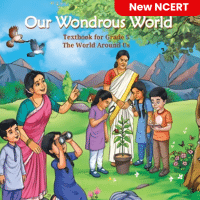Class 5 Exam > Class 5 Questions > Select the correct option regarding natural r...
Start Learning for Free
Select the correct option regarding natural resources.
- a)They can never be exhausted.
- b)They are obtained from soil only.
- c)Non-mineral resources include air and water.
- d)Some of the natural resources are harmful to us.
Correct answer is option 'C'. Can you explain this answer?
Verified Answer
Select the correct option regarding natural resources.a)They can never...
Useful products that we obtain from nature are called natural resources. They are never harmful. Some resources are exhaustible e.g., petrol, coal, etc. While some resources are inexhaustible e.g., sunlight, air, etc. Resources we get from soil are mineral resources e.g., gold, coal while those we get from other than soil are non-mineral resources e.g., air and water.
Most Upvoted Answer
Select the correct option regarding natural resources.a)They can never...
Natural resources are the materials and substances found in the environment that are valuable to humans. They are essential for the survival and development of life on Earth. Let's explore the correct option regarding natural resources, which is option C: Non-mineral resources include air and water.
Definition and Types of Natural Resources
Natural resources are classified into two main categories: renewable and non-renewable resources.
Renewable resources are those that can be replenished or regenerated naturally over time. Examples of renewable resources include sunlight, wind, water, forests, and fertile soil. These resources have the capacity to renew themselves and can be used indefinitely without depletion.
Non-renewable resources, on the other hand, are finite in nature and cannot be replenished once they are depleted. Examples of non-renewable resources include minerals (such as coal, oil, and natural gas), metals, and fossil fuels. These resources take millions of years to form and are being consumed at a much faster rate than they are being replenished.
Non-Mineral Resources: Air and Water
Non-mineral resources encompass a wide range of natural resources other than minerals. Two significant examples of non-mineral resources are air and water.
- Air: Air is a vital non-mineral resource that is essential for the survival of all living organisms. It is composed of various gases, primarily nitrogen (approximately 78%) and oxygen (approximately 21%). Air is necessary for respiration, the process by which organisms obtain energy from food. It also plays a crucial role in the water cycle, climate regulation, and the dispersal of seeds and pollen.
- Water: Water is another essential non-mineral resource required by all living organisms. It covers about 71% of the Earth's surface and is found in lakes, rivers, oceans, glaciers, and underground aquifers. Water is essential for drinking, irrigation, sanitation, transportation, and various industrial processes. It also supports aquatic ecosystems and plays a critical role in regulating the Earth's temperature.
These non-mineral resources, air and water, are crucial for the survival and well-being of all living beings. They are renewable resources that can be conserved and managed to ensure their availability for future generations.
Conclusion
In conclusion, natural resources are valuable assets that provide us with the necessary materials and substances for our survival and development. While non-mineral resources include air and water, they are distinct from mineral resources such as coal and oil. Understanding and conserving these resources is essential to ensure a sustainable future for our planet.
Definition and Types of Natural Resources
Natural resources are classified into two main categories: renewable and non-renewable resources.
Renewable resources are those that can be replenished or regenerated naturally over time. Examples of renewable resources include sunlight, wind, water, forests, and fertile soil. These resources have the capacity to renew themselves and can be used indefinitely without depletion.
Non-renewable resources, on the other hand, are finite in nature and cannot be replenished once they are depleted. Examples of non-renewable resources include minerals (such as coal, oil, and natural gas), metals, and fossil fuels. These resources take millions of years to form and are being consumed at a much faster rate than they are being replenished.
Non-Mineral Resources: Air and Water
Non-mineral resources encompass a wide range of natural resources other than minerals. Two significant examples of non-mineral resources are air and water.
- Air: Air is a vital non-mineral resource that is essential for the survival of all living organisms. It is composed of various gases, primarily nitrogen (approximately 78%) and oxygen (approximately 21%). Air is necessary for respiration, the process by which organisms obtain energy from food. It also plays a crucial role in the water cycle, climate regulation, and the dispersal of seeds and pollen.
- Water: Water is another essential non-mineral resource required by all living organisms. It covers about 71% of the Earth's surface and is found in lakes, rivers, oceans, glaciers, and underground aquifers. Water is essential for drinking, irrigation, sanitation, transportation, and various industrial processes. It also supports aquatic ecosystems and plays a critical role in regulating the Earth's temperature.
These non-mineral resources, air and water, are crucial for the survival and well-being of all living beings. They are renewable resources that can be conserved and managed to ensure their availability for future generations.
Conclusion
In conclusion, natural resources are valuable assets that provide us with the necessary materials and substances for our survival and development. While non-mineral resources include air and water, they are distinct from mineral resources such as coal and oil. Understanding and conserving these resources is essential to ensure a sustainable future for our planet.
Free Test
FREE
| Start Free Test |
Community Answer
Select the correct option regarding natural resources.a)They can never...
Select the correct option regarding natural resources.
ans
Non-mineral resources include air and water.

|
Explore Courses for Class 5 exam
|

|
Question Description
Select the correct option regarding natural resources.a)They can never be exhausted.b)They are obtained from soil only.c)Non-mineral resources include air and water.d)Some of the natural resources are harmful to us.Correct answer is option 'C'. Can you explain this answer? for Class 5 2025 is part of Class 5 preparation. The Question and answers have been prepared according to the Class 5 exam syllabus. Information about Select the correct option regarding natural resources.a)They can never be exhausted.b)They are obtained from soil only.c)Non-mineral resources include air and water.d)Some of the natural resources are harmful to us.Correct answer is option 'C'. Can you explain this answer? covers all topics & solutions for Class 5 2025 Exam. Find important definitions, questions, meanings, examples, exercises and tests below for Select the correct option regarding natural resources.a)They can never be exhausted.b)They are obtained from soil only.c)Non-mineral resources include air and water.d)Some of the natural resources are harmful to us.Correct answer is option 'C'. Can you explain this answer?.
Select the correct option regarding natural resources.a)They can never be exhausted.b)They are obtained from soil only.c)Non-mineral resources include air and water.d)Some of the natural resources are harmful to us.Correct answer is option 'C'. Can you explain this answer? for Class 5 2025 is part of Class 5 preparation. The Question and answers have been prepared according to the Class 5 exam syllabus. Information about Select the correct option regarding natural resources.a)They can never be exhausted.b)They are obtained from soil only.c)Non-mineral resources include air and water.d)Some of the natural resources are harmful to us.Correct answer is option 'C'. Can you explain this answer? covers all topics & solutions for Class 5 2025 Exam. Find important definitions, questions, meanings, examples, exercises and tests below for Select the correct option regarding natural resources.a)They can never be exhausted.b)They are obtained from soil only.c)Non-mineral resources include air and water.d)Some of the natural resources are harmful to us.Correct answer is option 'C'. Can you explain this answer?.
Solutions for Select the correct option regarding natural resources.a)They can never be exhausted.b)They are obtained from soil only.c)Non-mineral resources include air and water.d)Some of the natural resources are harmful to us.Correct answer is option 'C'. Can you explain this answer? in English & in Hindi are available as part of our courses for Class 5.
Download more important topics, notes, lectures and mock test series for Class 5 Exam by signing up for free.
Here you can find the meaning of Select the correct option regarding natural resources.a)They can never be exhausted.b)They are obtained from soil only.c)Non-mineral resources include air and water.d)Some of the natural resources are harmful to us.Correct answer is option 'C'. Can you explain this answer? defined & explained in the simplest way possible. Besides giving the explanation of
Select the correct option regarding natural resources.a)They can never be exhausted.b)They are obtained from soil only.c)Non-mineral resources include air and water.d)Some of the natural resources are harmful to us.Correct answer is option 'C'. Can you explain this answer?, a detailed solution for Select the correct option regarding natural resources.a)They can never be exhausted.b)They are obtained from soil only.c)Non-mineral resources include air and water.d)Some of the natural resources are harmful to us.Correct answer is option 'C'. Can you explain this answer? has been provided alongside types of Select the correct option regarding natural resources.a)They can never be exhausted.b)They are obtained from soil only.c)Non-mineral resources include air and water.d)Some of the natural resources are harmful to us.Correct answer is option 'C'. Can you explain this answer? theory, EduRev gives you an
ample number of questions to practice Select the correct option regarding natural resources.a)They can never be exhausted.b)They are obtained from soil only.c)Non-mineral resources include air and water.d)Some of the natural resources are harmful to us.Correct answer is option 'C'. Can you explain this answer? tests, examples and also practice Class 5 tests.

|
Explore Courses for Class 5 exam
|

|
Signup for Free!
Signup to see your scores go up within 7 days! Learn & Practice with 1000+ FREE Notes, Videos & Tests.



















